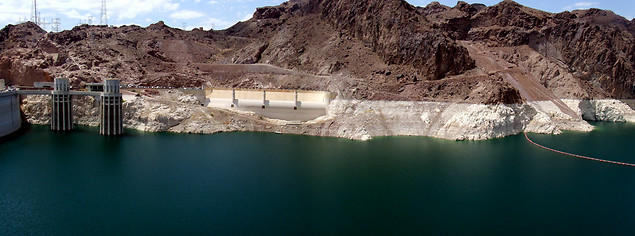 |
| Arches created due to mechanical weathering. |
Las Vegas 10 Years into the Future
Ten years doesn’t seem like a long time, but for Vegas, they may be seeing some changes happening in their landscapes as early as ten years. Of course with Las Vegas being in a desert region, there will be some mechanical weathering still occurring, but with only ten years passing, not enough would happen to drastically change the landscape. In my previous post, I explained about the water supply of Vegas. Las Vegas receives 90% of their water supply from Lake Mead at the Hoover Dam. From the year 2000 to 2010 the lake’s water has lowered 100 feet. With the maximum depth of Lake Mead being 590ft, 100ft is a drastic loss. If the cycle keeps repeating itself, then in ten years, Lake Mead can be more than half empty which in return can affect the entire city, both the landscape and tourism.
 |
| The "bathtub ring" at Lake Mead in 2010. |
Las Vegas 100 Years into the Future
 100 years into the future the mechanical weathering that creates the marvelous features will begin to be more noticeable. The arches that are seen in the present will begin to fall due to salt weathering. At the same time as these huge arches fall, the opposite will occur: more arches will begin to form. With there being a longer time span, we can also assume that Lake Mead may be dried out by then. The city of Las Vegas will have hopefully planned ahead and are aware that their main source of water will be gone, and they will need to find an alternative source or leave Vegas all together.
100 years into the future the mechanical weathering that creates the marvelous features will begin to be more noticeable. The arches that are seen in the present will begin to fall due to salt weathering. At the same time as these huge arches fall, the opposite will occur: more arches will begin to form. With there being a longer time span, we can also assume that Lake Mead may be dried out by then. The city of Las Vegas will have hopefully planned ahead and are aware that their main source of water will be gone, and they will need to find an alternative source or leave Vegas all together.
Las Vegas 1000 Years into the Future
In 1000 years Las Vegas would be nothing but dry rocks. Weathering will still take place, but with the water supply completely gone by now, there would be no way to live here. In 1000 years, this area will look completely different and hopefully the climate or weather patterns shift and convert it into a livable area.
 |
| What your vacation to Las Vegas may look like in 1000 years. |
Finally...
Although we won’t be around in 100 or 1000 years from now, it is interesting and a bit scary to think about what a physical landscape may look like. We cannot be for sure that in 1000 years there will even be life or Earth anymore, but if there was, we can use our knowledge to see what may happen to our world as we see it now and we can only hope that there actually will be life.





